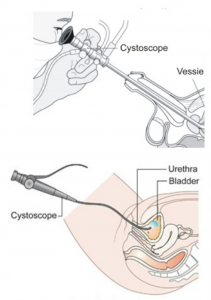CYSTOSCOPY (SCOPE)
Cystoscopy means examining the inside of the bladder. A retrograde pyelogram is a special X-ray showing the ureters (tubes between the kidneys and the bladder) and the kidney collecting system.A rigid cystoscopy requires general anaesthesia. The urethra (tube between the bladder and the outside) is lubricated and the instrument is passed gently into the bladder. Some sterile fluid is run into the bladder to allow the surgeon to inspect thelining fully. Small pieces of tissue (biopsies) may be taken for microscopic examination. If necessary, suspicious area of bladder lining (or areas of known tumour) can be removed for detailed examination.For a retrograde pyelogram, the surgeon passes a fine tube into the opening of the ureter and injects a contrast dye that shows up on X-ray. One or more X-rays are taken.
RISKS
These are the commoner risks. There may be other unusual risks that have not been listed here. Please ask you surgeon if you have any general or specific concerns.There are risks associated with any anaesthetic, you may have side effects from any drugs used. The commoner side effects include light-headedness, nausea, skin rash and constipation.
A cystoscopy has the following specific risks and limitations:
- You may notice some burning when you pass urine for the first few times after the operation. This should settle quickly.
- If a biopsy has been taken, you may notice some blood in the urine for a short while.
- A biopsy may not be enough to diagnose the abnormality, so you may need further tests.
- Extremely rarely, your bladder may be perforated during the operation. If this happens, you will need an open operation at the same time to stitch the hole closed. You will have a catheter in my bladder for a few days to keep it empty while the tissue heals, and you may need to stay in hospital for several days.
Retrograde pyelogram has the following specific risks and limitations:
- The procedure may be completed successfully but fail to show any abnormality (false negative) or may apparently show an abnormality that is not really there (false positive).
- Rarely the x-ray injection tubing may cause some minor trauma and bruising to the ureteric opening.
- Very rarely, the surgeon may not be able to find the ureteric opening, so the procedure cannot be performed.
Some of the above risks are more likely if you smoke, are overweight, diabetic, have high blood pressure or have had previous heart disease.
When you are discharged, take care of the following:
- You may have visible blood in the urine typically 24-48 hours and could last longer
- You may have burning, and difficulty voiding typically 24-48 hours and could last longer
- For the next 24-48 hours increase fluids (especially water)
- Avoid caffeine, alcohol, spicy and acidic foods
- Soak in a hot tub (as warm as you can tolerate) 3 times a day, 10 minutes at a time
- Take pain medications and/or antibiotics as directed, if prescribed
Please call your doctor if you experience the following:
- When the blood in the urine is getting worse instead of better (bright red urine), or if you are passing clots
- If you develop a fever
- Experience any chills, fatigue
- Unable to pass urine after 6 hours
